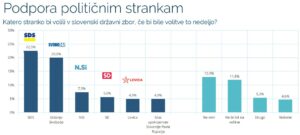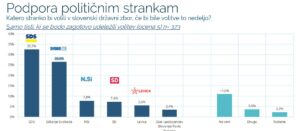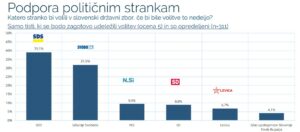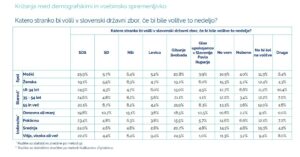The popularity of the so-called wonder boy of the energy industry, Robert Golob, has apparently started to dwindle. The Freedom Movement party (Gibanje Svoboda), of which Golob is the president, has started to fall behind the largest opposition party, the Slovenian Democratic Party (Slovenska demokratska stranka – SDS). Also, judging by the results of a recent public opinion poll, the ruling coalition has lost its majority support for the first time since the elections. The latest poll, conducted by the Parsifal Agency between the 4th and 9th of September, shows that if the elections had been held this Sunday, the SDS party would have won 34.5 percent of the vote among the voters who already know who they would vote for, while the Freedom Movement party would have won 30.6 percent of the vote. The difference in the percentages when it comes to people who would definitely attend the elections is even bigger – namely, 32.5 percent would vote for SDS and 26.5 percent for the Freedom Movement. “Over the period of a year or so, we have seen the disillusionment among the people, as well as the fact that the promises and hopes that the voters had invested in these new faces are not being fulfilled. Those who made big promises either refuse to or are unable to deliver on them,” political analyst Dr Matevž Tomšič commented on the poll.
If we first look at the results from all the respondents, we can see that if asked, “Which party would you vote for in the Slovenian National Assembly if the elections were held this Sunday?” 22.5 percent of respondents would answer that it would be the SDS party. In second place would be the Freedom Movement party, with 20 percent of the vote, and in third place would be the New Slovenia party (Nova Slovenija – NSi), with 7.3 percent of the vote.
The other two coalition parties – the Social Democrats (Socialni demokrati – SD) with 5.6 percent of the vote and the Left party (Levica) with 4.9 percent of the vote would come fourth and fifth. However, Pavel Rupar’s Voice of Pensioners (Glas upokojencev) would also cross the parliamentary threshold, with 4.9 percent of the vote.

12.9 percent of respondents are not yet sure who they would vote for, and 11.8 percent would not vote at all if the elections were held this Sunday. 5.3 percent said they would vote for another party, and 4.6 percent said they would not vote for any political party.
Support among the voters who already know who they would vote for
There is a significant difference between the first and the second-placed party among the voters who already know who they would vote for. Namely, the SDS party would get 34.5 percent of the vote, the Freedom Movement 30.6 percent, and NSi 11.2 percent. The coalition party SD would have received 8.6 percent of the vote, the coalition Left party 7.6 percent, and the Voice of the Pensioners of Slovenia, led by Pavel Rupar, would have received 7.5 percent of the vote.

Fluctuations in support
If we look at the fluctuations in support for the parties over time, we can see that support for the first-placed SDS party has been growing since March, while support for the Freedom Movement has been declining since March. In June, despite the decline in support, the Freedom Movement continued to lead before the SDS party, but then the trend reversed, with the former ruling SDS party returning to first place.
Among voters who would definitely attend the elections, the SDS party is clearly ahead
51 percent of respondents said they would definitely vote in the next parliamentary elections. Among those who would definitely vote in the hypothetical Sunday’s elections, the largest share (32.5 percent) would support SDS, followed by the Freedom Movement (26.5 percent) and the NSi (7.8 percent), SD (7.4 percent), and Levica (5.6 percent) parties.

11.0 percent of respondents do not know who they would vote for. 3.6 percent of respondents would vote for someone else, and 2.2 percent would not vote for any party. Among those who would surely go vote and who already know who they would vote for, the largest number (39.1 percent) would support SDS, followed by the Freedom Movement (31.9 percent) and NSi (9.4 percent).

If we look at the cross between demographic and substantive variables, we can see that SDS supporters include more men (25.9 percent) than women (19.1 percent). Most supporters of the largest opposition party belong to the middle age group (35-54 years) and have a secondary level of education. The supporters of the Freedom Movement are also more male (20.8 percent) than female (19.2 percent). Most of the supporters of the leading party belong to the highest age group (55+) and have the highest education level. The NSi party and Pavel Rupar’s Voice of Pensioners of Slovenia have more women among their supporters, while the government parties SD and Levica have a higher number of male supporters. The Left party has the highest number of supporters in the youngest age group (18-34) and among those with the highest level of education. The SD party has the highest number of supporters in the oldest age group and among those with the lowest education level. The NSi party has the highest number of supporters in the middle and oldest age groups, with those with the lowest education levels leading. Pavel Rupar’s Voice of Pensioners of Slovenia has the most supporters in the oldest age group and among those with the lowest education level.

We asked political analyst Dr Matevž Tomšič to comment on the poll, and he said that if we look at the overall data, the SDS party’s advantage is not that big, but when it comes to those who know they would vote for and those who would definitely go to the polls, the advantage increases. “It is difficult to say now whether this trend will continue. Something similar has happened to the Freedom Movement as has happened to all the new face parties, which had very high support at the beginning, but support started to fall quite quickly.” In June, he said, the Freedom Movement was still in the lead, i.e., they held on to it for a year and a half, and then the party started to lose the support.
“Over the period of a year or so, we have seen the disillusionment among the people, as well as the fact that the promises and hopes that the voters had invested in these new faces are not being fulfilled. Those who made big promises either refuse to or are unable to deliver on them,” he commented, pointing out that something similar to what is now happening to Golob, also happened to Miro Cerar, who won the elections convincingly, only to see his support plummet in the first half of his mandate. “Whether something similar will happen to Golob or not, there are some similarities. But that does not necessarily mean that a new face will not emerge again at the next elections and succeed in convincing the voters.”
When asked if the drop in support was due to the ever-increasing taxation of the people, he pointed out that this government’s focus on taxation was already known and clear before the elections, but people still supported this party and, consequently, this coalition. Although he said that it was too early to say how successful the recovery itself would be, it seemed that there was now so much dissatisfaction with all sorts of things (inefficiency, various excesses from this ruling party). All this had contributed to the results we now see, and the people have yet to feel the so-called solidarity contribution, but he said that that was only one of the pebbles in the mosaic and far from being the only reason for the drop in support.
As for the other parties, Tomšič said that none of them had managed to make a breakthrough. The SD party has not done well, and the same applies to the Left party. “It is interesting to see that the Left party is not able to strengthen itself because, after all, the success of a party is reflected in the achievement of its goals. From the point of view of their voters, one would think that they have done well. In many respects, the party sets the agenda for the government. Meanwhile, the fact that the SD party is failing to rise does not surprise me, because the party is acting as if it is disoriented, not knowing whether to move more to the left or more to the centre. The NSi party is also failing to make a breakthrough with their so-called more moderate policy, i.e., a policy that is slightly more open to cooperation with the government.” According to Tomšič, the SDS party has a stable electorate, which means that support for it can rarely fall very deeply. “But again, the question is whether this can now be enough to win an election, because if we look at the last 15 years or more, we can see that most of the time, the SDS party has been in the lead.” One of the other things that is important in relation to elections is the realisation that if a government is not successful, it is not a guarantee that it will lose the elections. “All these new faces came in with high expectations and failed to deliver.”
Demographic data
The survey was conducted between the 4th and 9th of September 2023, and it included 732 respondents, of which 49.6 percent were women. The average age of the participants is 51.5 years, and the standard deviation is 16.4 years. The majority of the respondents are from the oldest age group (45.0 percent), a slightly smaller share of participants belongs to the middle age group (34.5 percent), and the smallest number of respondents is from the youngest age group (20.5 percent). The majority of the respondents have completed high school (32.2 percent), followed by those with completed high education or higher (27.3 percent), 23.2 percent of respondents have finished vocational school, and 17.3 percent have either completed or have not completed primary school. The majority of the respondents currently reside in a small village or hamlet (55.1 percent), followed by those who live in the city (29.7 percent) or a smaller town (15.2 percent). Most of the respondents are from Central Slovenia (27.1 percent), followed by the Podravska (15.6 percent) and Savinjska (12.3 percent) regions.


